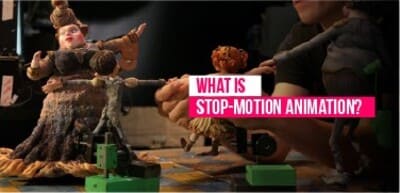What is Stop-Motion Animation
What is Stop-Motion Animation?
Experience the captivating world of stop-motion animation, a remarkable filmmaking stop-motion technique that breathes life into inanimate objects through meticulous frame-by-frame captures. It involves moving and manipulating physical objects incrementally while capturing a frame for each movement. This method creates the illusion of motion when the frames play in rapid succession. Stop-motion animation has a rich history, with the first known example dating back to the late 19th century. This blog explores how stop-motion animation works, its techniques, and its various types that showcase the boundless creativity of this art form.


How does stop-motion animation work?
Stop-motion animation captures a series of individual frames, each representing a slight movement or alteration in the scene. These frames are then compiled and played sequentially to create the illusion of movement. Various stop-motion animation techniques, such as incrementally moving objects, manipulating puppets, or reshaping clay models, can be used. Stop-motion animation requires careful planning, precise movements, and attention to detail to ensure smooth motion.

Discover how Seamedu can greatly improve and elevate your child’s skills in Film Making
Hands-On Training: Engage in practical exercises that prepare your child for real-world Film Making challenges.
Industry-Expert Faculty: Your child will learn from experienced professionals who bring valuable insights to the learning experience.
Networking Opportunities: Connect with industry professionals to open up career-enhancing possibilities for your child’s future.
 +91 020 46607500
+91 020 46607500
Types of stop motion animation
Cutouts
Cutouts animation involves using two-dimensional characters or objects typically created from paper, cardstock, or similar materials. These cutouts are then manipulated and moved between each frame to create the animation. An excellent example of cutout animation is from the movie "The Adventures of Prince Achmed" (1926), directed by Lotte Reiniger. The film utilised intricately cut silhouette characters to bring the story to life.
Clay and Puppets
Clay and puppet animation use three-dimensional models made from clay or other moldable materials. These models are carefully shaped and positioned, with incremental adjustments made between each frame. One of the most famous examples of clay animation is the "Wallace and Gromit" series, created by Nick Park. These clay models were meticulously posed and captured frame by frame, breathing life into these beloved characters.
Pursue a Career in Film Making.
Ready to embark on a Film Making? Complete the form below to take your first step towards your passion.
Fill Out the FormLive-Action
Live-action stop motion combines real actors or objects with stop-motion techniques. It involves integrating live-action footage with stop-motion animation to create stunning visual effects. An example of live-action stop motion is from the movie "Fantastic Mr Fox" (2009), directed by Wes Anderson. The film used a combination of puppetry and stop-motion animation to bring the characters to life uniquely and charmingly.
Stop-motion animation is a versatile and captivating art form that continues to inspire filmmakers and audiences alike. Using different stop-motion animation techniques and materials, animators can create incredible worlds and narratives that captivate and entertain. Whether cutouts, clay and puppets or live-action integration, stop-motion animation offers endless storytelling and artistic expression possibilities.


CATEGORIES
- MBA Program
- Data Science and Analytics
- Cloud Computing
- Data Analytics and Business Intelligence
- AI and Digital Systems
- Cyber Security and Digital Forensics
- Business Analytics & Intelligence
- Banking & Financial Services
- International Business
- Digital Marketing
- Research Paper
- Media & Entertainment
- Media Management
- Journalism and Media Production
- Media & Information Technology
- Visual Communication
- Game Development
- Sound Engineering
- Game Art & Design
- Photography
- Film Making
- Animation & VFX
Are you aspiring to become a proficient Film Making professional?
Look no further; we are committed to nurturing the potential of young minds. Are you ready to enhance your skills?


